British Surrender at Yorktown
General George Washington led his combined Continental and French Army into Virginia in mid-September 1781 to trap the British Army under General Lord Charles Cornwallis at Yorktown. To support Washington, the French fleet arrived in the Chesapeake on August 30 and six days later outgunned the British at the Battle of the Capes. On September 28, Washington’s army of 16,000 men opened the siege of Yorktown. Two weeks later, the last British outer forts were captured by Colonel Alexander Hamilton and his men.
Tom Hand, creator and publisher of Americana Corner, discusses the events leading to the British surrender at Yorktown, and why it still matters today.
Images courtesy of Library of Congress, Brown University Library, Yale University Art Gallery, Naval History and Heritage Command, Mount Vernon, The New York Public Library, Library of Virginia, Smithsonian Institution, The Metropolitan Museum of Art, Picryl, Wikipedia.


General George Washington led his Continental Army and the French Army under General Jean-Baptiste de Rochambeau into Virginia in mid-September 1781. The combined force was on its way to Yorktown and its appointment with destiny with the entrapped British command of General Lord Charles Cornwallis.